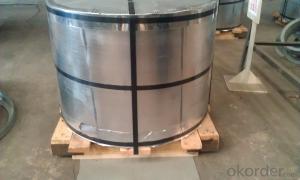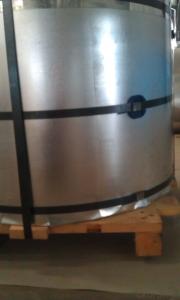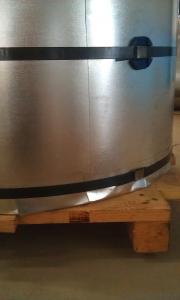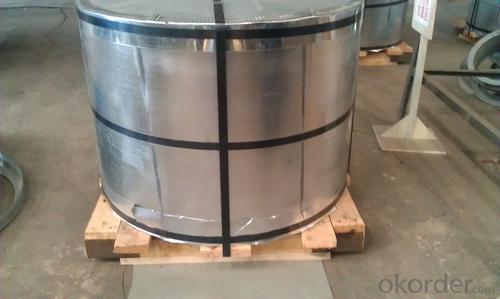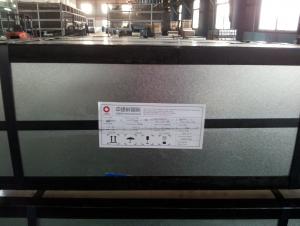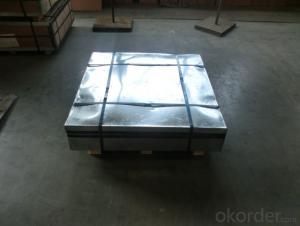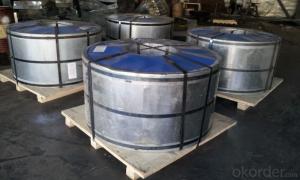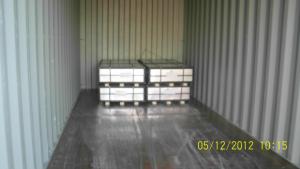Quality of Tin Free Steesl TFS
- Loading Port:
- China Main Port
- Payment Terms:
- TT OR LC
- Min Order Qty:
- -
- Supply Capability:
- -
OKorder Service Pledge
OKorder Financial Service
You Might Also Like
Tin Free Steel (TFS)
Is also known as chromed steel, as it is obtained by coating the metal base (low-carbon steel) with an ultra-thin layer of metallic chrome and then with a chromium oxide layer.This steel product was developed to meet economic requirements, and excels tinplate in paintability, paint adhesion, and economy. It is widely used for making beverage cans and 18-liter cans. It is also used for making photographic film cases and as a protective material for optical fiber cables.
Our TFS Specification:
Standard: AISI, ASTM, BS, DIN, GB, JIS
Material: MR,SPCC
Thickness:0.15mm - 0.45mm
Width: 600mm -1150mm
Temper: T1-T5
Annealing: BA & CA
Coil Inner Diameter: 508mm
Weight: 6-10 tons/coil 1~1.7 tons/sheets bundle
Oil: DOS
Surface: Finish,bright,stone,matte,silver
Packing:
1、For sheets: plastic or waterproof paper, metallic cover and angles, steel strips,wooden pallet.
2、For Coils: plastic or waterproof paper,plastic protect plate,steel strips.
Both Prime and Second Quality Are Available!!!
- Q: What are the common storage and handling requirements for tinplate?
- Common storage and handling requirements for tinplate include storing it in a dry and well-ventilated area, away from moisture and direct sunlight. It should be kept in a temperature-controlled environment to prevent any damage or corrosion. Proper handling techniques, such as using gloves and avoiding sharp objects, should be followed to prevent any surface scratches or dents. Tinplate should also be stacked and stored in a way that prevents any deformation or structural damage.
- Q: How does tinplate perform in microwave ovens?
- Tinplate is not suitable for use in microwave ovens as it can cause sparks and potentially damage the appliance.
- Q: How does tinplate packaging contribute to product marketing?
- Tinplate packaging contributes to product marketing in several ways. Firstly, it enhances the visual appeal of the product, making it more attractive to potential customers. The shiny and vibrant nature of tinplate packaging can catch consumers' attention and create a positive first impression. Additionally, tinplate packaging can be customized with high-quality printing, allowing for brand logos, product information, and eye-catching designs to be prominently displayed. This helps build brand recognition and reinforces brand image. Moreover, tinplate packaging provides durability and protection, ensuring that the product remains in good condition during transportation and on store shelves. This reliability can instill trust in consumers and enhance the perceived value of the product. Overall, tinplate packaging plays a crucial role in differentiating products from competitors and influencing purchasing decisions through its visual appeal, branding opportunities, and protective qualities.
- Q: What industries commonly use tinplate?
- The industries that commonly use tinplate include the food and beverage industry, packaging industry, automotive industry, and electronics industry.
- Q: How does tinplate packaging protect against moisture and oxygen?
- Tinplate packaging creates a protective barrier against moisture and oxygen due to its inherent properties. The tin coating on the steel substrate acts as a reliable shield, preventing the entry of moisture and oxygen into the packaged contents. This barrier ensures the preservation and freshness of the product, extending its shelf life and preventing spoilage or degradation caused by exposure to these elements.
- Q: What are the main challenges in tinplate coil handling?
- The main challenges in tinplate coil handling include ensuring proper lifting and transportation techniques to avoid damage, managing the weight and size of the coils for safe handling, maintaining cleanliness to prevent contamination, and implementing efficient storage and inventory management systems. Additionally, coordinating with suppliers and customers to ensure timely delivery and minimizing transit damage are also significant challenges.
- Q: Can tinplate be recycled?
- Yes, tinplate can be recycled. Tinplate is made from steel coated with a thin layer of tin, and both steel and tin are recyclable materials. Recycling tinplate involves separating the steel and tin layers, melting them down, and then reusing them to make new products. Recycling tinplate helps conserve natural resources and reduces waste.
- Q: What are the main applications of tinplate in the aerosol industry?
- Tinplate is primarily used in the aerosol industry for manufacturing aerosol cans and containers. Its main applications include packaging of various aerosol products such as paints, lubricants, adhesives, and personal care products like deodorants and hairsprays. Tinplate cans ensure product safety, resist corrosion, and provide an excellent barrier against oxygen and moisture, making them ideal for preserving the integrity and longevity of aerosol contents.
- Q: How does tinplate contribute to sustainable packaging?
- Tinplate contributes to sustainable packaging as it is 100% recyclable and can be reused indefinitely without losing its properties. It also provides excellent barrier properties, protecting the contents from light, oxygen, and moisture, thus extending the shelf life of the packaged products. Additionally, tinplate is lightweight, reducing transportation costs and emissions.
- Q: How does tinplate compare to aluminum in terms of properties and applications?
- Tinplate and aluminum have distinct properties and applications. Tinplate is steel coated with a thin layer of tin, making it corrosion-resistant, ductile, and easily solderable. It is commonly used for food and beverage packaging, as well as in construction and automotive industries. On the other hand, aluminum is lightweight, non-corrosive, and possesses high thermal and electrical conductivity. It finds extensive use in aerospace, electrical, and packaging industries due to its strength and recyclability. While tinplate offers better barrier properties, aluminum excels in weight reduction and energy efficiency. Hence, the choice between the two depends on specific needs and requirements.
Send your message to us
Quality of Tin Free Steesl TFS
- Loading Port:
- China Main Port
- Payment Terms:
- TT OR LC
- Min Order Qty:
- -
- Supply Capability:
- -
OKorder Service Pledge
OKorder Financial Service
Similar products
Hot products
Hot Searches
Related keywords
